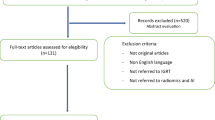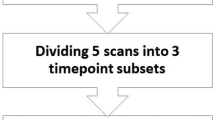Abstract
Purpose
To identify the optimal technique of radiotherapy for patients with high-grade glioma.
Materials and methods
CT scans of 10 patients with grade IV glioma were reviewed for the treatment planning. Three different treatment plans were generated using 3D conformal radiotherapy (3DCRT), intensity-modulated radiotherapy (IMRT), and RapidArc (RA), and the plans were compared.
Results
Planning target volume (PTV) coverage was comparable. However, IMRT and RA gave better sparing of critical structures. Treatment time and monitor units (MU) for RapidArc were much less when compared to IMRT. Conclusions: If PTV is near to the organs at risk (OAR), then IMRT gives good results in comparison to 3DCRT plans. RapidArc is faster than IMRT and 3DCRT for same dose prescription to PTV and constraints of OAR.
Résumé
Objectif
Identifier la technique optimale de radiothérapie pour les patients porteurs de gliome de haut grade.
Matériel et méthodes
Les tomodensitogrammes prévisionnels de dix patients porteurs de gliomes de grade IVont été analysés. Trois séries de plans ont été générés et comparés: radiothérapie conformationelle 3D (3DCRT), radiothérapie avec modulation d’intensité (IMRT) et arcthérapie dynamique (RA).
Résultats
La couverture du volume cible prévisionnel (PTV) est comparable. Cependant l’IMRT et le RA préservent davantage les organes critiques. Le temps de traitement et le nombre d’unités moniteur (MU) en arcthérapie sont nettement inférieurs à ceux de l’IMRT.
Conclusions
Si le PTV est proche d’organes à risque (OAR), l’IMRT donne des résultats satisfaisants par rapport aux plans 3DCRT. L’arcthérapie est plus rapide que l’IMRT et le 3DCRT pour les mêmes prescriptions de dose pour le PTV et les mêmes contraintes d’OAR.
Similar content being viewed by others
References
Stupp R, Hegi ME, Mason W, et al (2009) Effects of radiotherapy with concomitant and adjuvant temozolomide versus radiotherapy alone on survival in glioblastoma in a randomised phase III study: 5-year analysis of the EORTC-NCIC trial. The Lancet 10:459–466
Clivio A, Fogliata A, et al (2009) Volumetric-modulated arc radiotherapy for carcinomas of the anal canal: A treatment planning comparison with fixed field IMRT. Radiother Oncol 92:118–124
Cozzi L, Dinshaw KA, Shirvastave SK, et al (2008) A treatment planning study comparing volumetric arc modulation with RapidArc and fixed field IMRT for cervix uteri radiotherapy. Radiother Oncol 89:180–191
Fogliata A, Nicolini G, Vanetti E, et al (2006) Dosimetric validation of the anisotropic analytical algorithm for photon dose calculation: fundamental characterization in water. Phys Med Biol 51:1421–1438
Bragg CM, Conway J (2006) Dosimetric verification of the Anisotropic Analytical Algorithm for radiotherapy treatment planning. Radiother Oncol 81:315–323
Shaffer R, Nichol AM, Vollans E, et al (2009) A comparison of volumetric modulated arc therapy and conventional intensitymodulated radiotherapy for frontal and temporal high-grade gliomas. Int J Radiat Oncol Biol Phys 76: 1177–1184
Vorwerk H, Wagner D, Hess CF (2008) Impact of different leaf velocities and dose rates on the number of monitor units and the dose-volume-histograms using intensity modulated radiotherapy with sliding-window technique. Radiat Oncol 3:31–40
Emami B, Lyman J, Brown A, et al (1991) Tolerance of normal tissue to therapeutic irradiation. Int J Radiat Oncol Biol Phys 21:109–122
Nelms BE, Simon JA (2007) A survey on IMRT QA analysis. J Appl ClinMed Phys 8:76–90
Korreman S, Medin J, Kjaer-Kristoffersen F (2009) Dosimetric verification of RapidArc treatment delivery. Acta Oncol 48:185–191
Dobler B, Streck N, Klein E, et al (2010) Hybrid plan verification for intensity-modulated radiation therapy (IMRT) using the 2D ionization chamber array I’mRT MatriXX - a feasibility study. Phys Med Biol 55:N39–N55
Harms WB, Low DA, Purdy JA, Wong JW (1994) A software tool to quantitatively evaluate 3D dose calculation algorithms. Int J Radiat Oncol Biol Phys 30:187
Low DA, Harms WB, Sasa Mutic, Purdy JA (1998) A technique for the quantitative evaluation of dose distributions. Med Phys 25:656–661
Minniti G, Traish D, Ashley S, et al (2005) Risk of second brain tumor after conservative surgery and radiotherapy for pituitary adenoma: Update after an additional 10 years. The Journal of clinical endocrinology & metabolism 90:800–808
Author information
Authors and Affiliations
Corresponding author
About this article
Cite this article
Goswami, B., Banerjee, S., Mitra, S. et al. Optimal planning strategies for high-grade gliomas : a dosimetric study on ten patients. J Afr Cancer 4, 168–170 (2012). https://doi.org/10.1007/s12558-012-0219-8
Received:
Accepted:
Published:
Issue Date:
DOI: https://doi.org/10.1007/s12558-012-0219-8




